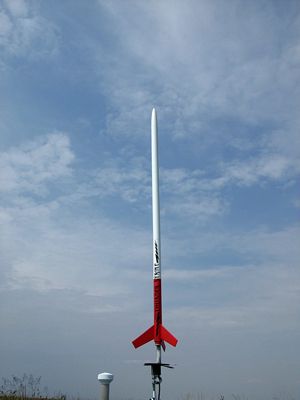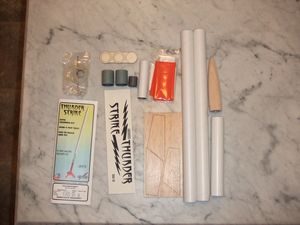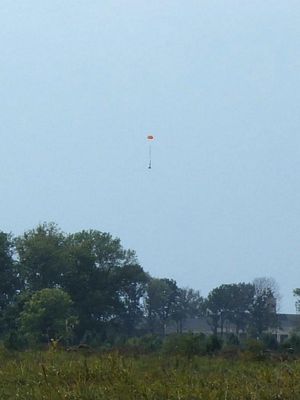| Construction Rating: | starstarstarstarstar_border |
| Flight Rating: | starstarstarstarstar |
| Overall Rating: | starstarstarstarstar |
| Diameter: | 1.34 inches |
| Manufacturer: | Semroc  |
| Skill Level: | 1 |
| Style: | Sport |

Brief:
Right on the heels of the Thunder Chief release, Semroc rolled out the Thunder Strike at NARAM-51. The Thunder line
of kits might seem a little confusing, so I'll offer up this quick tour in ascending order of size. All are basic 3FNC
with long, sleek styling, swept fins, and fairly high performance.
The smallest is the currently available Thunder Bee at 15". Next in size is the not yet available Thunder Hawk at 22", followed by the released Thunder Chief at 32", the not released yet Thunder Bird at 42", this Thunder Strike at 51", the not released Thunder Roc at 60", and the biggest of the bunch and soon to be released Thunder Storm at 72". The Thunder Bee has always been one of my favorite 13mm models, so I've enjoyed working my way up the line as the rest of the family is released.
Construction:
Parts are the typical excellent quality from Semroc, with a fair amount of tubing in the $22.50 retail package. Parts
list:
- Balsa nose cone
- BT-56 payload tube
- 2 BT-56 body tubes
- 2 TC-56 couplers
- Plywood bulkhead disk
- Laser cut balsa fins (3)
- 24mm motor tube, centering rings, engine block, E-sized metal hook
- 3/16" launch lugs
- 16" heavy plastic chute
- Kevlar®/elastic shock cord
- Waterslide decals
- D/E motor spacer

As was the case with the other Thunder models, construction on this is fairly easy and straightforward with plenty of computer-drawn illustrations. I would definitely rate this a skill level 1 type kit. Construction took me about 90 minutes plus finishing time.
The motor mount is a standard tube with pair of centering rigs, forward engine block (centering ring), and a metal hook. The Kevlar® line is anchored to the forward bend of the metal hook.
The lower body tube is marked next for 3 fins using a template on the instruction sheet. Once marked, it's now OK to glue in the motor mount with about 3/8" of the tube left extending out the aft end of the body tube, a characteristic of the Thunder series (other than the minimum diameter Thunder Bee).
I tacked on fins with CA, followed by yellow and white glue fillets, but I took care of spirals and grains beforehand, when it's much easier to sand down the surfaces.
The launch lugs are bonded next, one in the fin/tube joint and the other eyeballed towards the forward end of the lower body tube. I'm not a fan of manually aligning lugs, so I wound up extending the fin line the whole length of the tube, which I could then use for the offset to align the upper lug.
Due to the length of this model, it's a bit more complex than the other Thunders currently available. Rather than count on pushing a chute the length of the 40+ inches of body tube, the upper 2/3 of the model is pushed out as a payload. This is handled by gluing a plywood disk inside the tube coupler and anchoring a metal screw eye into its center. The upper (shorter) body tube then finishes off the payload and can either be glued to the middle body tube/coupler or friction fit and/or taped at flight. If you're into the cosmetics, you'd be better gluing the nose cone and upper body tube to the middle tube so that the seams can be filled and smoothed over. If you want a functional payload, leave them removable. I wanted to use this model to work through some staging timer trouble I'd been having, so I went for the detachable payload option.
Finishing:
The standard color scheme for the Thunder line is colored bottom third, white top 2/3. I'd done Dayglo yellow on the
Thunder Bee and Thunder Chief, and on this one I wanted to stick with the cover art, going red on the aft end.
All grains and spirals had been pre-treated using Elmer's Fill 'n' Finish so painting was a breeze. I shot one light coat of primer using Rustoleum's new 2x coverage paint, which tends to go on a bit heavy but dries fast and doesn't run very easily. I am really liking that line of paint versus the reformulated Krylon gunk.
After the primer coat, I lightly wet sanded it with 400 grit, then hit everything with a gloss white (again, Rustoleum 2x coverage). I masked the upper section and finished up hitting the fins and lower area with a cherry red.
The final touch was applying the pair of decals that form the Thunder Strike name with lightning bolts. One tip though: measure the decals first before deciding where to mask off the contrasting colors on the body. I just sort of eyeballed the break without thinking about the decals and wound up going a bit too far up with the red. You can see in the pad shot that the red is between the 'S' and 't' of Strike, rather than separating Thunder and Strike as intended.
Construction Rating: 4 out of 5

Flight:
I caught a magnificent flying day for the maiden flight with clear skies and winds barely hitting 5 mph. I was
wearing shorts though and the field was pretty overgrown with lots of thorns, ticks, and various reasons to not want a
half mile recovery walk so I wimped out with a D12-5.
The boost was almost perfect, just a slight angle into the wind towards the end of burnout. Of the three (different size) Thunders currently available, this was the slowest and most graceful flier. The -5 was right at apogee, a perfect motor selection.
I think an E9-6 would be a great selection as well, and when conditions permit, I think I might even slip in an F12 to really send this one up.
Recovery:
The parachute supplied with this is a 16" parachute made of a more rugged plastic, and has Tyvek reinforcement
tabs as well. It deployed perfectly and was easy to spot as it gently descended. I recovered the model about 300 yards
away, having caught a slight thermal on the way down, and the model was in perfect condition.
Flight Rating: 5 out of 5
Summary:
What can I say? Easy to build, looks great, and flies great. I'm delighted to see the Thunder line finally starting
to grow and highly recommend at least one version in your favorite motor range.
Overall Rating: 5 out of 5
 |
 |
Flights
Sponsored Ads
 |
 |











